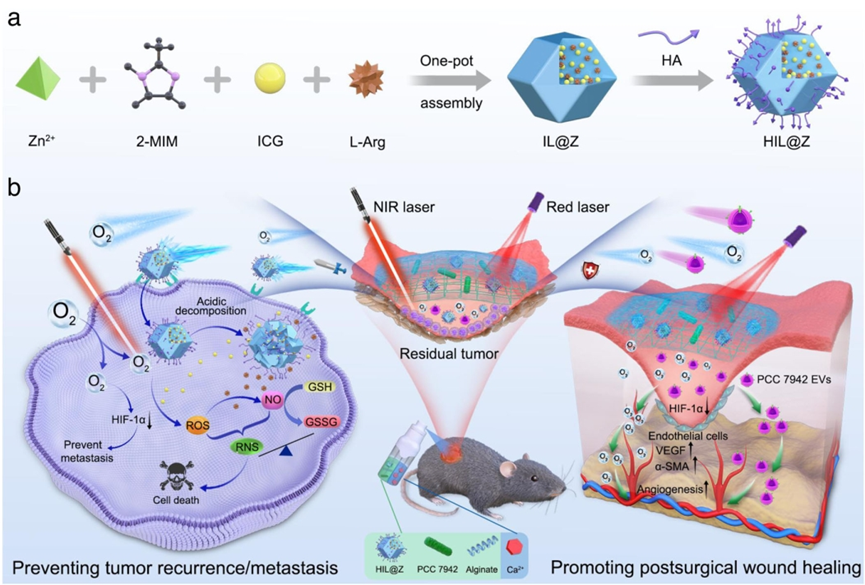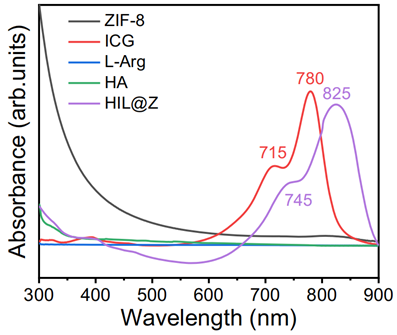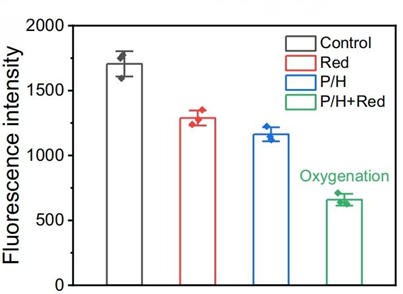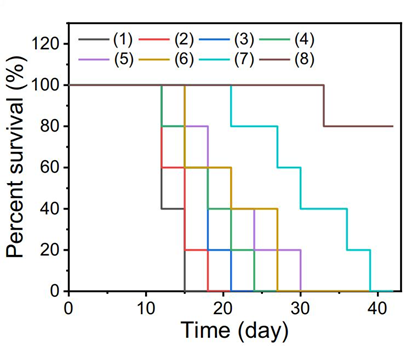A newly developed sprayable hydrogel that combines tumor-targeted nanodrugs and photosynthetic cyanobacteria shows promising results in preventing tumor recurrence and promoting wound healing post-surgery for malignant melanoma.
Key Highlights
- Research Question:
Can a sprayable therapeutic hydrogel prevent tumor recurrence and enhance wound healing in patients undergoing surgery for malignant melanoma? - Research Difficulties:
The study faced challenges related to the hypoxic microenvironment after surgery, which contributes to tumor recurrence and delayed wound healing. - Key Findings:
The hydrogel not only inhibits tumor recurrence through redox homeostasis disruption but also promotes healing by continuously supplying oxygen and enhancing angiogenesis. - Innovative Aspects:
This research introduces a dual-action hydrogel that utilizes photosynthetic cyanobacteria to provide a sustained oxygen supply at the surgical site, addressing hypoxia-related complications. - Importance of the Study:
This study offers a novel approach to combat both tumor recurrence and wound healing challenges, potentially improving the quality of life for melanoma patients and expanding treatment options.
Malignant Melanoma: Treatment Challenges and Innovations
Malignant melanoma is the deadliest form of skin cancer, characterized by its aggressive nature and high propensity for metastasis. The disease often arises from existing moles or skin lesions, making early detection crucial for effective treatment. Surgical resection remains the primary intervention, but challenges such as tumor recurrence and delayed wound healing significantly impact patient outcomes. The post-surgical hypoxic microenvironment, resulting from impaired oxygen supply and increased oxygen demand of rapidly proliferating tumor cells, exacerbates these issues. Current therapeutic approaches, including chemotherapy and radiation, often fall short due to their lack of specificity and significant side effects. Thus, novel strategies that can address both tumor recurrence and wound healing are urgently needed to enhance the quality of life and survival rates for melanoma patients.
A Multifunctional Hydrogel for Tumor and Hypoxia Management
Conducted by a team of researchers from Southwest Jiaotong University, including Shuiling Chen, Yang Luo, and others, the study was published in Nature Communications.
The primary aim of this study is to develop an innovative therapeutic hydrogel that can effectively prevent tumor recurrence and promote wound healing in patients undergoing surgical resection for malignant melanoma. Specifically, the research seeks to address the dual challenges of local tumor recurrence and delayed healing due to the hypoxic microenvironment that characterizes post-surgical conditions. To achieve this, the study has set the following objectives:
- Design and synthesize a sprayable therapeutic hydrogel that encapsulates a tumor-targeted nanodrug and photosynthetic cyanobacteria.
- Evaluate the hydrogel’s efficacy in disrupting cellular redox homeostasis in tumor cells through photodynamic therapy.
- Assess the hydrogel’s ability to generate oxygen to alleviate hypoxia in the post-surgical environment.
- Analyze the hydrogel’s impact on enhancing angiogenesis and accelerating the wound healing process.
- Conduct preclinical testing using animal models to determine the hydrogel’s effectiveness in preventing tumor recurrence and promoting wound healing.

Figure 1. Schematic illustration of sprayable HIL@Z/P/H for efficiently preventing tumor recurrence/metastasis and simultaneously promoting wound healing during the postsurgical cancer treatment.
Research Methods & Findings
Experimental Process Outline
- Synthesize tumor-targeted nanodrug (HIL@Z) by loading indocyanine green (ICG) and L-arginine (L-Arg) into zeolite imidazole framework (ZIF-8) nanoparticles.
- Coat HIL@Z with hyaluronic acid (HA) to enhance targeting capability.
- Prepare the sprayable therapeutic hydrogel (HIL@Z/P/H) by encapsulating HIL@Z and photosynthetic cyanobacteria (PCC 7942) in calcium alginate.
- Conduct in vitro studies to evaluate cellular uptake and oxygenation effects.
- Perform in vivo experiments using a postsurgical melanoma model to assess tumor recurrence and wound healing.
- Analyze histological samples for cellular response and angiogenesis markers.
Key Experiments
1. Synthesis and Characterization of HIL@Z Nanodrug
- Procedure: The HIL@Z nanodrug was prepared through the coordination between Zn²⁺ and 2-methylimidazole (2-MIM), mixing ICG and L-Arg into ZIF-8 nanoparticles, followed by HA coating.
- Result: Scanning electron microscopy (SEM) and transmission electron microscopy (TEM) images revealed spherical morphologies, with elemental mapping confirming uniform distribution of C, O, N, Zn, and S in HIL@Z.
- New Finding: The successful encapsulation of ICG and L-Arg was validated by UV-vis spectroscopy, showing characteristic peaks at 745 nm and 825 nm for HIL@Z, indicative of ICG oligomer formation.

Figure 2. UV-vis spectra of different nanoparticles.
2. Efficacy of HIL@Z/P/H in Tumor Cell Oxygenation
- Procedure: B16F10 cells were subjected to treatment with HIL@Z/P/H under 635 nm laser irradiation, and oxygen levels were monitored using the hypoxia-sensitive probe Ru(dpp)3Cl2.
- Result: Fluorescence intensity analysis showed significant decreases in hypoxic conditions after treatment with P/H+Red, indicating effective oxygenation in tumor cells.
- New Finding: The treatment significantly alleviated intracellular hypoxia, demonstrating the hydrogel’s ability to enhance oxygen supply in malignant environments.

Figure 3. Fluorescence intensities of Ru(dpp)3Cl2-stained B16F10 cells after different treatments.
3. In Vivo Assessment of Tumor Recurrence and Wound Healing
- Procedure: An incomplete tumor resection model was established in female mice, where HIL@Z/P/H was sprayed at the surgical site and treated with Red and NIR laser irradiation.
- Result: The HIL@Z/P/H+Red+NIR group showed a significant reduction in tumor size, with some tumors completely disappearing, and 80% survival rate observed over 42 days.
- New Finding: Histological analysis via TUNEL staining indicated a higher apoptotic rate in the HIL@Z/P/H+Red+NIR group compared to controls, emphasizing the treatment’s effectiveness in promoting cell death in residual tumor cells.

Figure 4. Changes of mouse survival rate.
Findings and Therapeutic Implications for Melanoma
The researchers emphasize the critical role of the hypoxic microenvironment in both tumor recurrence and delayed wound healing, which are major challenges faced by melanoma patients. They highlight that current therapeutic strategies are often limited by their inability to address these issues effectively. The use of the HIL@Z/P/H hydrogel represents a significant advancement, as it not only targets and treats residual tumor cells through photodynamic therapy but also alleviates hypoxia by providing a continuous oxygen supply via photosynthesis. The findings suggest that this innovative approach could enhance the efficacy of existing treatments and improve overall survival rates. Moreover, the study opens avenues for future research into the application of this hydrogel in other types of cancers and in various clinical settings where hypoxia is a concern, thereby broadening the impact of this research on cancer therapy and wound healing.
Reference:
Chen, Shuiling, et al. “In-situ-sprayed therapeutic hydrogel for oxygen-actuated Janus regulation of postsurgical tumor recurrence/metastasis and wound healing.” Nature Communications 15.1 (2024): 814.
